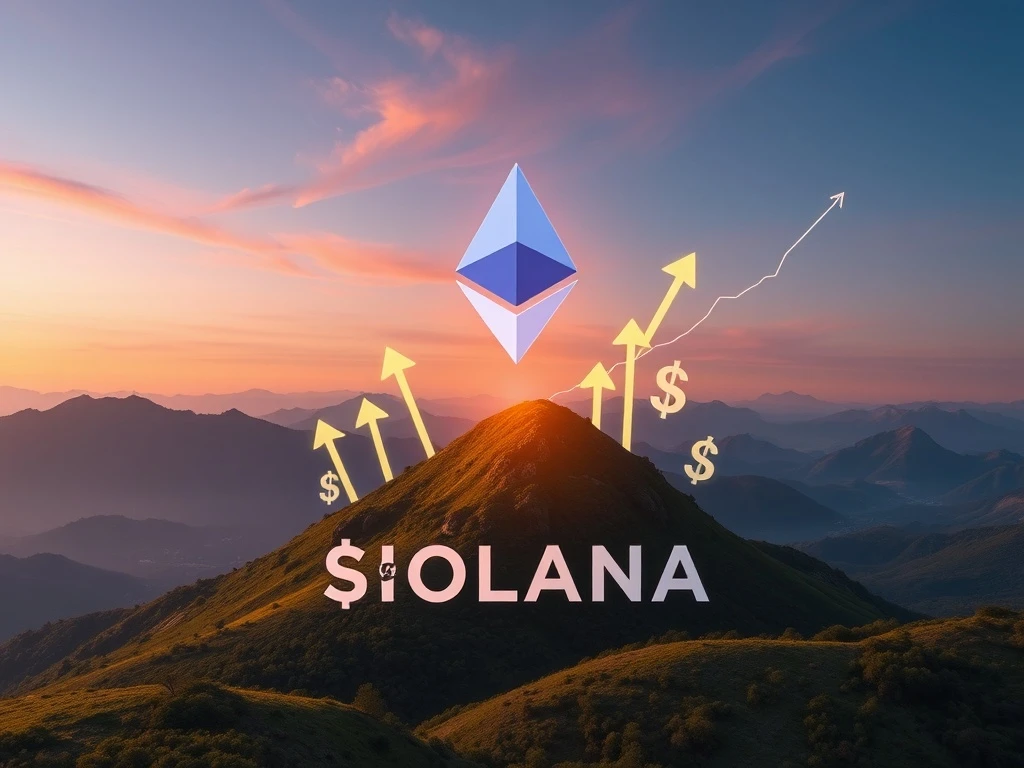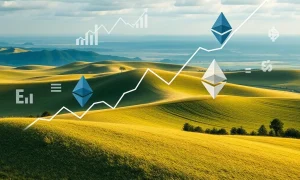For entrepreneurs and investors in the dynamic world of cryptocurrency, understanding market shifts is crucial. Recently, a significant trend has emerged: Ethereum (ETH) is outpacing its competitors, including Solana and even Bitcoin, in attracting fresh capital. This shift signals growing confidence in the second-largest cryptocurrency, potentially paving the way for a retest of the critical $4,000 price level. This article delves into the key metrics driving Ethereum’s ascendancy and what they mean for its future trajectory.
Ethereum Dominates Capital Inflows
Capital rotation within the altcoin market currently favors Ethereum. Data from Glassnode indicates that Ether has become the primary beneficiary of recent investment flows. Specifically, the SOL/ETH Hot Capital Ratio, which measures short-term realized capital movement between Solana and Ethereum, has plummeted to a year-to-date low of 0.045. This represents a substantial 42% decline since April, strongly suggesting that while both ETH and SOL saw inflows in July, the flow of capital is now overwhelmingly shifting towards Ether.
The Hot Realized Cap metric helps identify which assets short-term speculators prefer. The downtrend in the ETH/SOL trading pair over several months points to a notable ETH-led rotation, as Glassnode reports. Furthermore, the ETH/BTC pair also shows significant strength. It recently reached multi-month highs, climbing above its 200-day exponential moving average for the first time in over two years. This technical breakout signifies renewed investor confidence in Ethereum relative to Bitcoin. Consequently, Ether’s price has rebounded to its average trading range, while Bitcoin continues to face selling pressure below the $116,000 mark. This divergence highlights Ethereum’s individual strength in the current market cycle.


Rising Open Interest and Ethereum’s Futures Dominance
Ethereum‘s open interest (OI) recently reached an all-time high of $58 billion. This substantial increase in OI, coupled with Ethereum’s record-high daily transaction count, indicates more capital entering the market and growing network participation. Open interest reflects the total number of outstanding derivative contracts, such as futures or options, that have not been settled. A rising OI, especially when accompanied by price appreciation, often signals strong market conviction and fresh money flowing into the asset.
Moreover, Ethereum’s share of total open interest across major exchanges has climbed to 34.8%. Conversely, Bitcoin’s share has decreased from 59.3% to 47.1%. This shift underscores a growing preference among derivatives traders for Ethereum exposure. It suggests that speculative capital is increasingly betting on ETH’s upward momentum. This dominance in the futures market provides further evidence of Ethereum’s increasing prominence and investor interest, moving beyond just spot market activity.

Understanding Ethereum’s Funding Rates
Despite its impressive surge, Ethereum has yet to definitively reclaim the crucial $4,000 resistance level. However, futures funding rates suggest that the current rally still possesses significant upward potential. Funding rates are periodic payments made between long and short traders in perpetual futures markets. Positive funding rates mean long positions pay short positions, indicating bullish sentiment. Conversely, negative rates mean short positions pay longs.
Currently, aggregated funding rates for Ether remain considerably lower than during previous attempts to breach $4,000, specifically in March and December 2024. In fact, compared to March, funding rates have nearly halved. This dynamic is bullish for two primary reasons. Firstly, lower funding rates indicate that traders are not excessively leveraged on the long side. This reduces the risk of sudden liquidations, which often trigger sharp price corrections. Secondly, it suggests that current price action is driven more by robust spot demand rather than excessive speculative positioning. Indeed, NovaDius president Nate Geraci highlights that “Eth treasury companies & spot eth ETFs have *each* bought approx 1.6% of current total eth supply since beginning of June.” This substantial spot accumulation provides a solid foundation for price stability and growth.

The Road to $4,000 for Ethereum
Ethereum corrected by 9.72% over the past seven days after rallying for five consecutive weeks. Nevertheless, ETH swiftly recovered 9% since, retesting $3,800 on Thursday. With the psychological $4,000 level firmly in sight, crypto analyst Jelle notes that this level “has been resistance since forever.” He further adds, “Once it breaks, I doubt we go back below anytime soon. Price discovery is close.” Price discovery occurs when an asset moves into an uncharted territory, with no historical resistance levels to impede its ascent. This scenario often leads to rapid and significant price increases.
The resilience shown by Ether in recovering quickly after a correction underscores strong underlying demand. This demand is fueled by various factors, including the increasing utility of the Ethereum network, ongoing developments like EIP-4844 (proto-danksharding) enhancing scalability, and growing institutional interest. Furthermore, the anticipation of spot Ethereum ETFs in various jurisdictions continues to build bullish sentiment. These factors collectively contribute to a robust outlook for Ethereum, making the $4,000 target a highly plausible near-term objective.
Broader Implications for the Ethereum Ecosystem
The sustained capital inflows and strong market metrics for Ethereum extend beyond mere price action; they signify a thriving ecosystem. Ethereum remains the backbone of decentralized finance (DeFi), non-fungible tokens (NFTs), and a vast array of decentralized applications (dApps). Increased capital means more liquidity for DeFi protocols, fostering innovation and greater user participation. This renewed interest could potentially spark what some analysts refer to as a ‘DeFi Summer 2.0,’ characterized by a resurgence in decentralized application usage and investment.
Network activity also provides a bullish signal. Ethereum’s daily transaction count has reached record highs, demonstrating robust network utilization. This high transaction volume suggests that developers and users actively engage with the blockchain, validating its utility and adoption. Moreover, ongoing upgrades, such as the upcoming Pectra (Prague + Electra) upgrade, aim to further enhance Ethereum’s scalability, security, and decentralization. These continuous improvements reinforce Ethereum’s position as a leading smart contract platform, attracting both users and developers and solidifying its long-term value proposition.
Market Context and Future Outlook for Ethereum
In the broader cryptocurrency market, Ethereum‘s performance stands out amidst fluctuating sentiment. While Bitcoin often dictates overall market trends, Ether’s ability to decouple and attract independent capital flows highlights its unique value proposition and growing maturity. The current macroeconomic environment, characterized by evolving inflation expectations and central bank policies, continues to influence risk assets like cryptocurrencies. However, Ethereum’s fundamental strengths, including its robust developer community, diverse ecosystem, and deflationary tokenomics post-Merge, position it favorably to navigate these external pressures.
Looking ahead, the long-term outlook for Ethereum remains positive. Its foundational role in Web3, coupled with continuous technological advancements, suggests sustained growth. The increasing institutional adoption, exemplified by the interest in spot ETH ETFs and treasury company accumulation, indicates a broader acceptance of Ethereum as a legitimate asset class. As the digital economy evolves, Ethereum is well-positioned to remain a critical infrastructure layer, driving innovation and attracting further investment. This sustained interest reinforces the potential for Ethereum to not only retest but potentially surpass the $4,000 mark in the foreseeable future.
Ethereum‘s recent outperformance in capital inflows, coupled with strong futures market dynamics and favorable funding rates, paints a clear picture of its robust position in the cryptocurrency landscape. The growing institutional and spot demand, alongside its pivotal role in the decentralized ecosystem, suggests that the $4,000 target is increasingly within reach. As the market continues to evolve, Ethereum’s fundamental strengths and ongoing development initiatives are likely to maintain its upward trajectory.
This article does not contain investment advice or recommendations. Every investment and trading move involves risk, and readers should conduct their own research when making a decision.
Frequently Asked Questions (FAQs)
Why is Ethereum attracting more capital than Solana?
Ethereum is attracting more capital primarily due to a shift in investor sentiment, as indicated by Glassnode’s SOL/ETH Hot Capital Ratio. This suggests short-term speculators are favoring Ether. Additionally, Ethereum’s established ecosystem, robust network activity, and anticipated developments like spot ETFs contribute to its appeal over newer alternatives like Solana.
What does ‘Open Interest’ mean for Ethereum’s price?
Open Interest (OI) represents the total number of outstanding derivative contracts for Ethereum. A rising OI, especially when accompanied by price increases, indicates fresh capital entering the market and strong conviction among traders. It suggests that more money is betting on Ethereum’s future price movements, signaling bullish sentiment.
How do low funding rates impact Ethereum’s rally?
Low funding rates for Ethereum’s futures contracts are bullish for two main reasons. First, they show that traders are not overly leveraged, reducing the risk of sudden liquidations. Second, they suggest that the price increase is driven by genuine spot demand rather than excessive speculation. This creates a more sustainable rally.
What factors could help Ethereum reach $4,000?
Several factors could help Ethereum reach $4,000. These include continued strong capital inflows, increasing institutional adoption (e.g., spot ETH ETFs, treasury company accumulation), robust network utility and transaction volumes, ongoing technical upgrades improving scalability, and overall positive market sentiment towards decentralized technologies.
What is the significance of the ETH/BTC pair’s performance?
The ETH/BTC pair’s performance indicates Ethereum’s strength relative to Bitcoin. When ETH/BTC rises, it means Ethereum is outperforming Bitcoin. Its recent climb above the 200-day exponential moving average for the first time in over two years signifies a significant shift in market preference, showing renewed investor confidence in Ethereum as a standalone investment.
Is Ethereum’s current growth sustainable?
Ethereum’s current growth appears sustainable due to several factors: strong fundamental utility as the backbone of DeFi and dApps, continuous technological advancements, growing institutional interest, and a shift towards genuine spot demand rather than purely speculative futures trading. Its deflationary tokenomics post-Merge also contribute to long-term value.
























